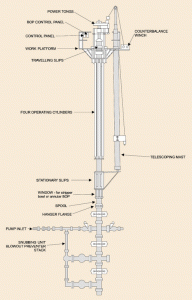Pre-planning critical to success of snubbing operations in HPHT shale wells

With coiled tubing becoming an increasingly difficult solution to well problems in the shale plays of Texas, snubbing has become a more viable method for dealing with HPHT environments, according to Steve Wehrenberg, US technical advisor for Boots and Coots, who made his presentation on “The Design and Application of Snubbing Units for HPHT Environments” at the SPE/ICoTA Coiled Tubing and Well Intervention Conference in the Woodlands, Texas, on the 23 March.
One of Mr Wehrenberg’s main points emphasized the importance of pre-planning. “A lot needs to be done (on a snubbing project), and the purpose of this paper is to demonstrate the importance of doing your homework before you start,” he said.
Basing his example off of the UK model definition of an HPHT well, which includes pore pressure in excess of .8 psi/ft, undisturbed bottomhole temperature greater than 300°F and well control equipment rated greater than 10,000 psi, Mr Wehrenberg discussed the 460K hydraulic snubbing unit that was used to replace the coiled-tubing system on a Haynesville Shale well.
Mr Wehrenberg stressed the importance of calculating the tri-axial loading when pre-planning the well remediation operation, not looking toward a technical book to determine tri-axial proportions. His presentation noted that even though tri-axial loading is frequently named the cause of tubular failure downhole, it is often overlooked in pre-planning stages.

He advised the audience, “You’re going to have a lot of equipment out there, so send someone out (to the site) to inspect, because you can’t have everything showing up at once.”
Pre-planning also lies in solidifying crew competency on the job site.
“Make sure the people involved have adequate skills to work in this demanding environment. Sometimes in this industry we are thrown into more hazardous situations, and you can’t just throw anyone out there,” he said.




